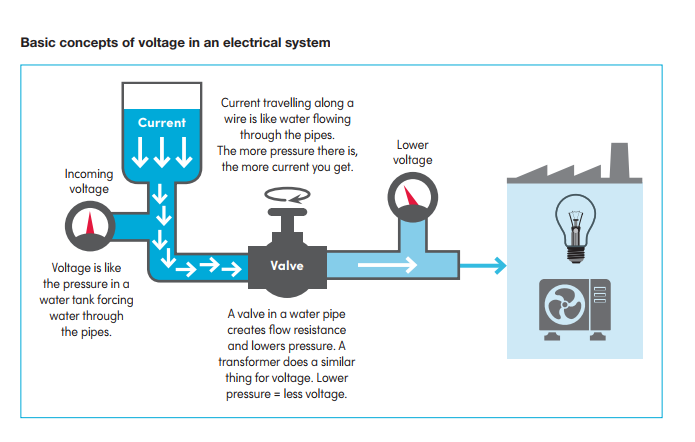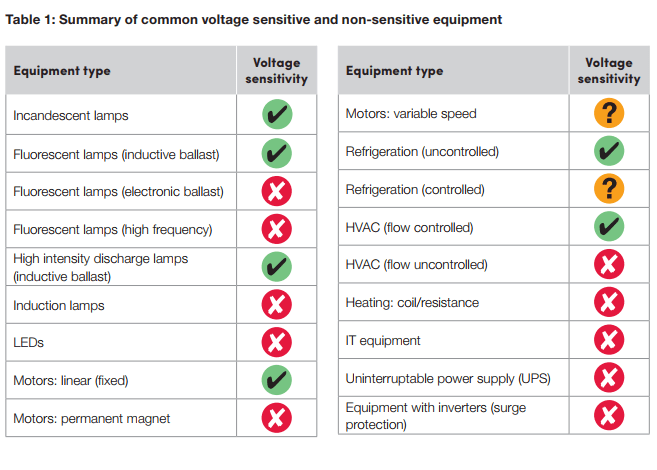Electricity flows through power wires between 216 and 253 volts and voltage optimisation is the process of bringing it to as close as 230 volts as possible, based on Australian standards.
When the voltage is optimised, you can make substantial cost savings in terms of electricity use, wear and tear on equipment and it is also kinder to the environment.
What is voltage?

Voltage is the difference in potential energy between two points. All electrical equipment is dependent on voltage to operate. A reduction in voltage can reduce the energy consumed by certain equipment, therefore reducing electricity consumption and costs.
What is voltage optimisation?
Voltage optimisation is done to adjust the voltage levels from a wider range (i.e. supplied between 253 V and 216 V) to a narrower range (e.g. 230 V +\- 1%) that is optimal for your particular electrical equipment
In some cases, adjusting the supply voltage levels may lead to a reduction in electricity consumption and associated costs. The electrical current travelling along a wire is like water flowing through the pipes. The more pressure there is, the more current you get.
Meanwhile, voltage is like the pressure in a water tank forcing water through the pipes. A valve in a water pipe creates flow resistance and lowers pressure. A transformer does a similar thing for voltage. Lower pressure = less voltage.
Basically, Voltage optimisation works by appropriately reducing the voltage supplied to your site for individual equipment. Consequently, the electricity consumption and cost savings can only be achieved in equipment that is ‘sensitive’ to changes in normal supply voltage.
How can voltage optimisation benefit my site?
Potential benefits of voltage optimisation include:
- Equipment is supplied with the optimum voltage
- A reduction in energy consumption (and associated costs) and indirect greenhouse gas emissions
- An overall increase in the lifetime of electrical equipment
- Potential reduction in maintenance frequency, effort and costs • improvement in overall power quality (depending on the type of voltage optimisation technology implemented).
How does voltage optimisation apply to my site and which equipment does it affect?

Depending on the equipment that you use at your site and the supply voltage levels, you may benefit from controlling, reducing or optimising your voltage.
You can find out if implementing voltage optimisation on your site will work to your advantage by having specialists perform a voltage sensitivity check – Leading Edge Energy can arrange this service for you.
See the table below for a quick guide to voltage-sensitive and non-sensitive equipment:

What do I need to take into consideration?
- Voltage optimisation units may not be suitable for all sites and equipment types. Always consider both the current and future needs of your business and whether it is a good fit.
- This may not be the most appropriate energy management solution for your suite so always assess alternatives (such as equipment upgrades). As a decision maker within your business, it’s important to take a look at all aspects of any investment choice relative to your operations.
To learn more about voltage optimisation, the NSW government has a detailed guide on the subject that you can read here.
Aside from this article on voltage optimisation, we also have tips on air conditioning efficiency, updates on energy-related government policies, and more. Check out our Blog and News sections to read more, or visit our case studies to see how Leading Edge Energy was able to reduce electricity and gas costs for businesses all over the country.
Want to reduce your business’ energy bill too? Get in touch with our energy management consultants and we can help you find a way to manage your electricity and gas consumption and improve energy efficiency in general. Give us a call at 1300 852 770 or e-mail us at hello@leadingedgeenergy.com.au.













